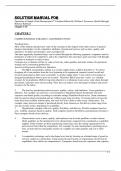Exam (elaborations)
Solution Manual For Operations & Supply Chain Management 8th Canadian Edition By William J Stevenson, Hydeh Mottaghi, Behrouz Bakhtiari Chapter 2-18
- Course
- Institution
Solution Manual For Operations & Supply Chain Management 8th Canadian Edition By William J Stevenson, Hydeh Mottaghi, Behrouz Bakhtiari Chapter 2-18
[Show more]



